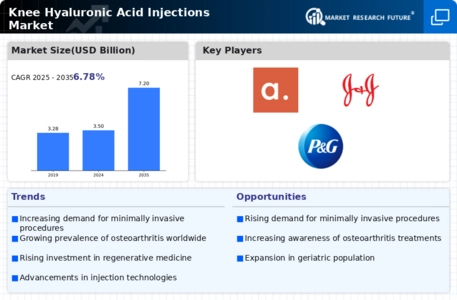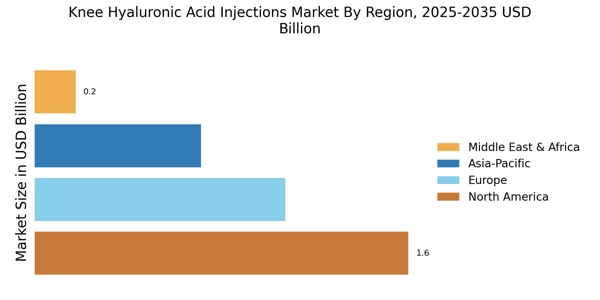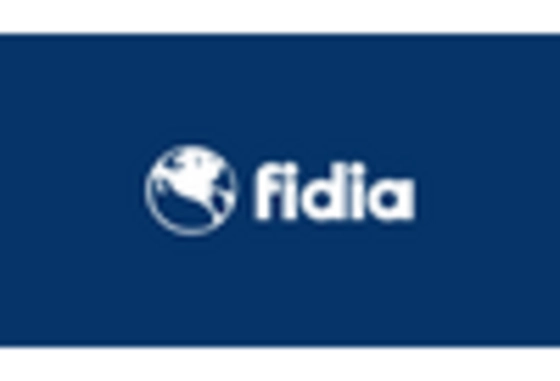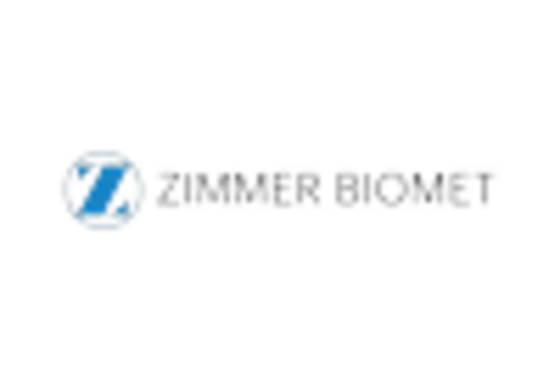Rising Healthcare Expenditure
An increase in healthcare expenditure is a significant driver for the Knee Hyaluronic Acid Injections Market. As countries allocate more resources to healthcare, patients gain better access to advanced treatment options, including hyaluronic acid injections. This trend is particularly evident in regions where healthcare reforms have led to improved insurance coverage for non-surgical treatments. Data suggests that higher healthcare spending correlates with increased utilization of innovative therapies, as patients seek effective solutions for joint pain and mobility issues. Consequently, the financial commitment to healthcare not only enhances patient access but also stimulates market growth for knee hyaluronic acid injections, as more individuals opt for these treatments to manage their conditions effectively.
Growing Awareness of Joint Health
The increasing awareness of joint health among the general population serves as a crucial driver for the Knee Hyaluronic Acid Injections Market. Educational campaigns and health initiatives have heightened public understanding of joint-related issues, particularly osteoarthritis. As individuals become more informed about the benefits of maintaining joint health, they are more likely to seek preventive and therapeutic measures. This awareness translates into a greater acceptance of hyaluronic acid injections as a treatment option. Market data indicates that patients who are educated about their conditions are more inclined to pursue non-surgical interventions, thereby propelling the demand for knee hyaluronic acid injections. As awareness continues to grow, the market is poised for further expansion, reflecting a proactive approach to joint health management.
Advancements in Product Formulations
Innovations in product formulations are driving the Knee Hyaluronic Acid Injections Market forward. Recent developments have led to the creation of more effective and longer-lasting hyaluronic acid products, enhancing their appeal to both patients and healthcare providers. These advancements may include improved viscosity, enhanced purity, and the introduction of combination therapies that offer synergistic benefits. Market analysis indicates that products with superior efficacy are likely to capture a larger share of the market, as patients seek the best possible outcomes from their treatments. As manufacturers continue to invest in research and development, the availability of advanced hyaluronic acid formulations is expected to stimulate market growth, meeting the evolving needs of patients seeking effective solutions for knee joint issues.
Increasing Prevalence of Osteoarthritis
The rising incidence of osteoarthritis is a primary driver for the Knee Hyaluronic Acid Injections Market. As populations age, the prevalence of this degenerative joint disease escalates, leading to a greater demand for effective treatment options. According to recent data, osteoarthritis affects millions worldwide, with knee joints being particularly susceptible. This condition often results in pain and reduced mobility, prompting patients to seek non-surgical interventions such as hyaluronic acid injections. The market for these injections is projected to expand as healthcare providers increasingly recommend them as a viable alternative to more invasive procedures. Consequently, the growing awareness of osteoarthritis and its impact on quality of life is likely to fuel the demand for knee hyaluronic acid injections, thereby driving market growth.
Shift Towards Minimally Invasive Procedures
The trend towards minimally invasive procedures significantly influences the Knee Hyaluronic Acid Injections Market. Patients and healthcare professionals alike are increasingly favoring treatments that offer reduced recovery times and lower risks of complications. Hyaluronic acid injections, known for their non-surgical nature, align well with this preference. Data indicates that a substantial percentage of patients express a desire to avoid surgery, leading to a surge in demand for alternatives like hyaluronic acid injections. This shift not only enhances patient satisfaction but also encourages healthcare providers to adopt these treatments more widely. As the medical community continues to embrace less invasive options, the market for knee hyaluronic acid injections is expected to experience robust growth, reflecting changing patient attitudes towards joint health management.


















Leave a Comment